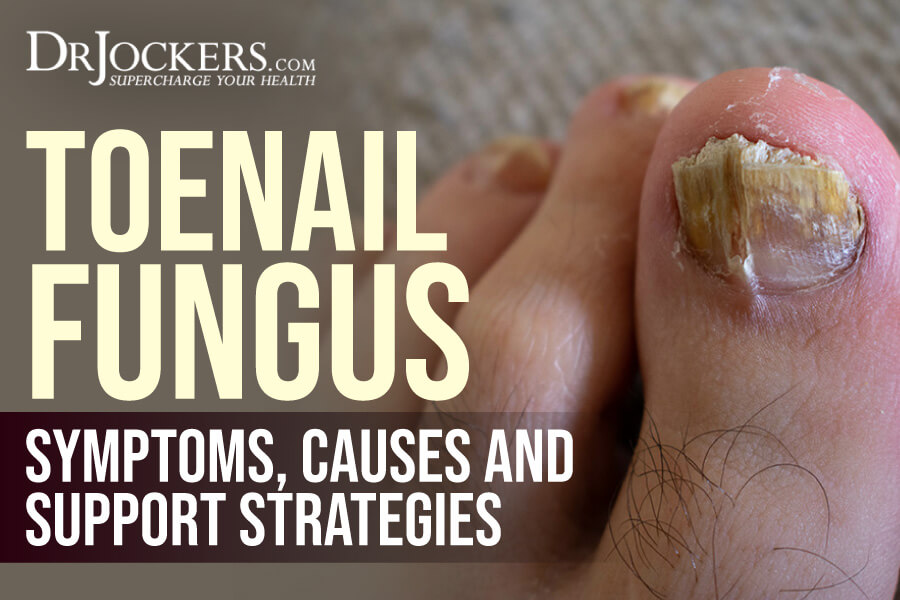 Toenail Fungus: Symptoms, Causes, and Support Strategies
Toenail Fungus: Symptoms, Causes, and Support Strategies
Toenail fungus is an experience most people have or will experience at one point in their life. It is a fungal infection affecting your toenails causing discoloration, thickening, brittleness, and other toenail issues. Conventional treatment strategies for toenail fungus only tend to address the symptoms.
Unfortunately, without addressing the root cause issues behind your problem, your toenail fungus will keep returning. The good news is that by using a few natural support strategies you can address the toenail fungus itself and the underlying causes, improving your health and reducing your risks for toenail fungus.
In this article, you will learn what toenail fungus is. You will learn about the signs and symptoms of toenail fungus. I will go over the different types of toenail fungus. You will understand the risk factors of developing toenail fungus.
I will explain your conventional treatment options for toenail fungus and potential issues with them. I will go over the root cause factors that may increase your chances of developing toenail fungus. I will offer my top natural strategies for toenail fungus to improve your health and well-being.

What is Toenail Fungus
Most people are familiar with and have experienced some form of a fungal infection affecting their feet, toes, skin, or toenails. Toenail fungus is a common fungal infection affecting the toenail of millions of Americans. It is also known as onychomycosis or tinea unguium.
According to a 2008 research article published in the Indian Journal of Pharmaceutical Science, toenail fungus is the result of underlying fungal growth and infection caused by dermatophytes, non-dermatophyte molds, Candida, or other yeasts (1). When these pathogens come in contact with cracked toenails or the skin around your toenails, it provides an excellent opportunity for them to take residence, grow, and cause problems.
According to the Institute for Quality and Efficiency in Health Care (IQWiG), about 3 to 12 percent of the population experiences toenail or fingernail fungus (2). It is more common in older people than young people, likely because of their generally weaker immune systems. Toenail fungus is also a common sign of Candida or other yeast overgrowths in your system that may result in other health issues.
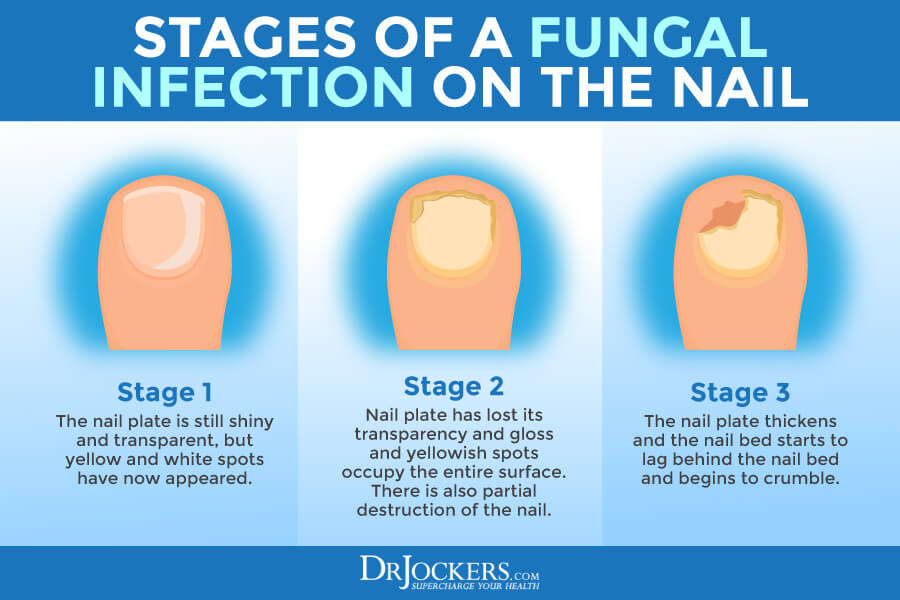
Signs and Symptoms of Toenail Fungus
Signs and symptoms of toenail fungus may include:
- Brittle nails, especially on the big toe, it’s a common symptom of tinea unguium
- Nails changing color, especially on the big toe, it’s a common symptom of tinea unguium
- Whitish-yellowish or brownish color on the side or the front of the nails
- Soft nails that break easily
- Nails that become thicker and change shape.
- Pain around the nails
- Nail that’s detaching from the nail bed or the skin.
- White patches on the surface of the nail, either small dots that spread out or large blotches.
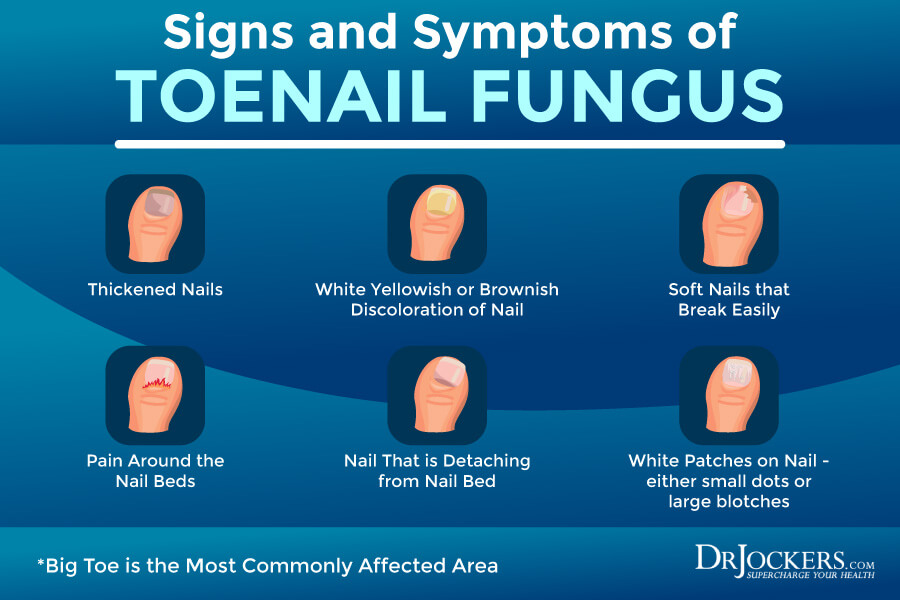
Different Types of Toenail Fungus
There are four different types of toenail fungus that you may develop at some point, including:
- Distal subungual onychomycosis: According to a 2009 book, Clinical Mycology, this type is responsible for about 58 to 85 percent of all toe fungus cases (3). It may be distinguished by crumbled or thick nails, discoloration, and scaling under the nail (subungual hyperkeratosis).
- Proximal subungual onychomycosis: According to a 2009 book, Clinical Mycology, this type is the most common in the immunosuppressed population (3). It is characterized by a white nail plate near the cuticle.
- White superficial onychomycosis: According to a 2012 book, Goldman’s Cecil Edition, his type only affects the surface of toenails (4). It makes your nails white and may make them turn crumbly.
- Candidal onychomycosis: According to a 2008 book, Pediatric Emergency Medicine, this form is caused by a Candida infection that affects the entire nail (5). In this type, your nail plate separates from the entire nail bed.
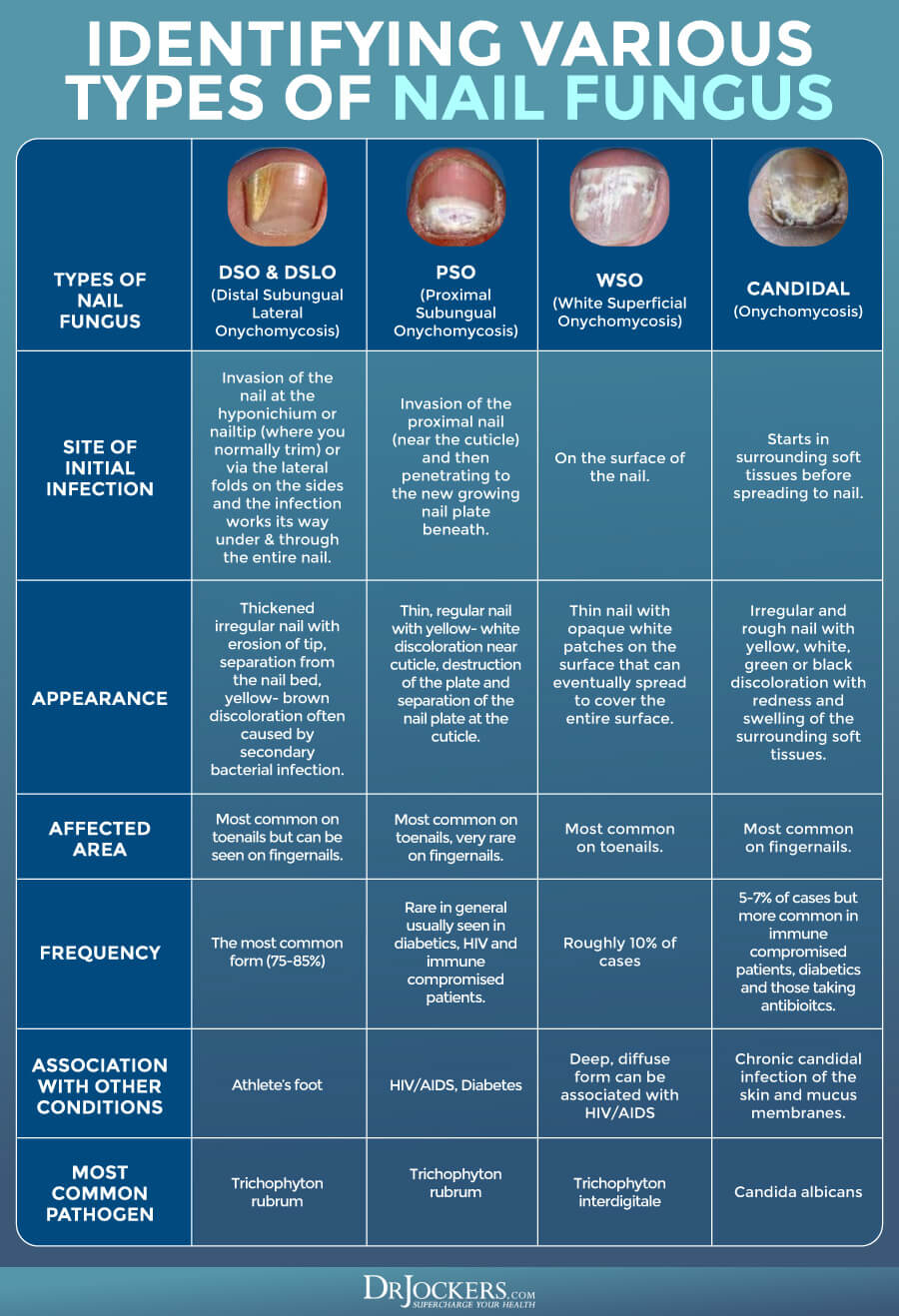
Risk Factors for Developing Toenail Fungus
Generally speaking, like all fungal infections, toenail fungus is a sign of an imbalance of harmful and beneficial bacteria in your gut. Having too many bad and not enough good bacteria living inside your gut increases the risk of pathogenic infections, including yeast and fungal overgrowth.
There are various underlying health issues and lifestyle factors that may increase the risk of imbalance and the risk of fungal overgrowth in your body. I will go over these potential root cause factors that may increase your risk in the next section.
However, beyond these underlying issues, there are certain factors that may increase your risk of developing toenail fungus. These potential risk factors for toenail fungus may include:
- Having athlete’s foot (a fungal foot infection)
- Coming in contact with fungi, especially at higher risk public places, such as contaminated swimming pools, saunas, nail salons, hotel showers, and gyms
- Having various skin conditions, such as psoriasis
- Having damaged nail beds
- Wearing dirty or tight shoes or socks
- Circulation issues affecting your legs from various health issues, including artery diseases or diabetes
- Having a weak immune system
- Genetic predisposition
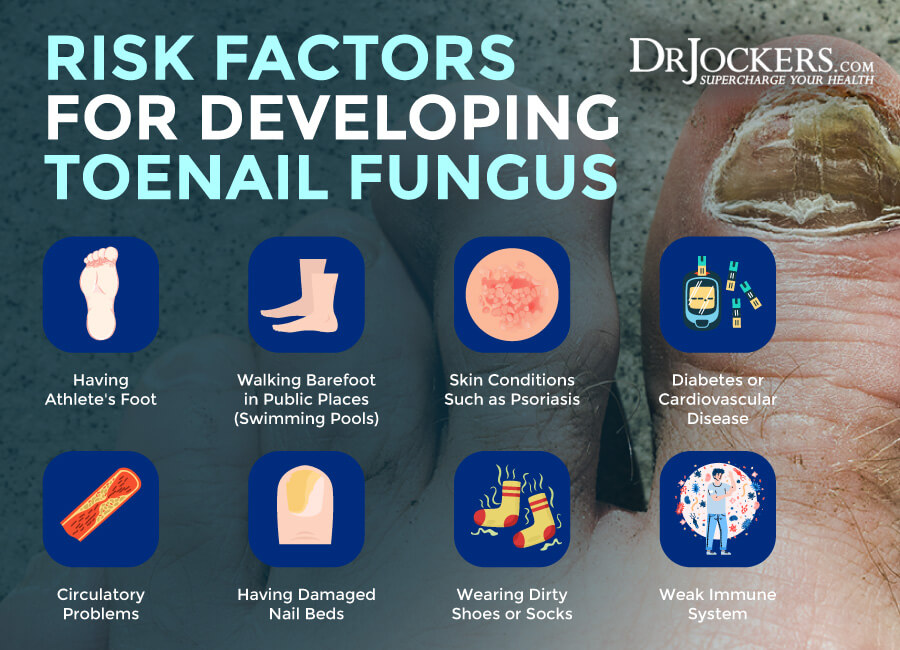
Conventional Treatment Options
Most people visit their dermatologist or podiatrist when experiencing toenail fungus. The conventional treatment options recommended by these doctors usually involve topical treatments or medications (2). These treatment options target the symptoms of the toenail fungus but not the underlying issues causing it.
Some of the options may involve long treatment that lasts for three to six months. Yet, many people may experience the fungus coming back again and again despite treatment. Medications in tablet form are generally more effective than topicals. However, they have more side effects and possible interactions, have to be used for longer periods and still don’t address the underlying issue.
Unless you address the underlying problem causing your toenail fungus in the first place, you may get rid of the symptoms with conventional strategies, but the problem will come back over and over again and will be more difficult to fight. In the next section, I will go over the possible root cause factors that may play a role in your toenail fungus problem. Then I will offer some natural support strategies to improve your health and reduce your risks.
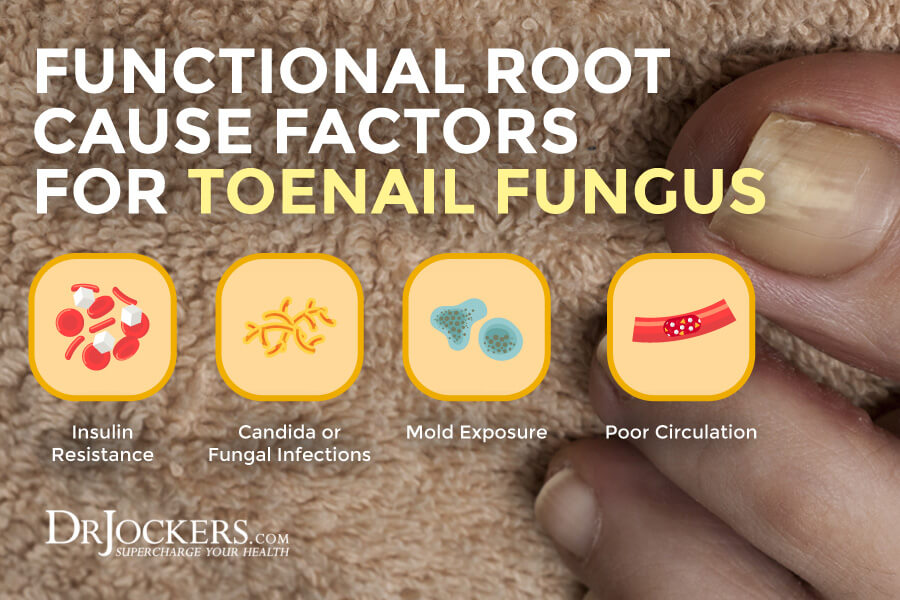
Root Cause Factors
Signs and symptoms of toenail fungus can show up slowly. They may take years to appear and spread. This means that treatment time may take several months as well. Addressing the underlying reasons behind toenail fungus is usually the best bet to ensure fast and long-term recovery. Let’s discuss the main root cause factors of toenail fungus that you may need to address to improve your health.
Insulin Resistance
Insulin resistance means that your body is unable to respond to insulin as it should. This means that it’s unable to use glucose properly for energy. This forces your body to make more insulin which over time also causes your body to make more glucose. Insulin resistance increases inflammation and increases the risk of blood sugar problems, prediabetes, diabetes, and other chronic health issues.
Having insulin resistance may also increase your risk of fungal and yeast infections. A 2018 study of over 300,000 participants published in Diabetes Care has found that people with diabetes had a higher risk of fungal infections (6). A 2016 cross-sectional observational study published in the Pakistani Journal of Medical Sciences has found that toe fungus and toenail fungus is more common in those with diabetes or diabetic foot ulcers (7).

Candida or Fungal Infections
Candida Albicans is a strain of yeast that occurs naturally in the digestive tracts of humans. In low amounts, it coexists with a diverse array of other microorganisms to make up the gut microbiome. When certain conditions allow candida to proliferate, problems can occur. It makes its home within the mucous membranes of the intestinal tract. When overgrowth occurs, it can compromise this fragile barrier and make its way into the bloodstream.
Candida overgrowth is one of the most common fungal infection that you may encounter. It can compromise your immune system and digestion, increase inflammation, and cause a list of issues, including problems with your skin and nails. Beyond Candida, you may develop other fungal infections.
Having a Candida or fungal infection in your body can increase your risk of developing symptoms on your foot or toes and having toenail fungus. Candida is even responsible for specific toenail fungal infections. According to a 2008 book, Pediatric Emergency Medicine, Candidal onychomycosis is a form of toenail fungus that’s caused by a Candida infection that affects the entire nail (5).

Mold Exposure
Mold is a fungus that can grow on almost anything, with the ability to thrive in many conditions but most specifically in warm temperatures and high moisture environments. The versatility of mold allows for this fungus to grow in both indoor and outdoor environments, making it an invasive presence in both your outdoor area and most importantly in your indoor areas such as your home. Mold loves to hide in your bathroom, kitchen, basement, behind wallpaper, behind drywall, and under your carpet. It can become a serious issue if you have a moisture leak or flooding or live or work in an unkempt or old building.
When you are exposed to mold chronically, you can develop mold toxicity symptoms. Mold may also increase your risk of toenail fungus. According to a 2008 research article published in the Indian Journal of Pharmaceutical Science, toenail fungus may develop because of non-dermatophyte molds (1). According to a 2015 study published in the Annals of Brasilian Dermatology, mold exposure can increase the risk of toenail fungus (6).

Poor Circulation
Certain medical issues, including poor circulation, may increase your risk of toenail fungus as well. One of the top reasons behind poor circulation in your legs is peripheral artery disease (PAD) caused by a narrowing of your arteries and blood vessels. It tends to affect smokers and those over 50 more commonly. Additionally, Raynaud’s syndrome, blood clots, and diabetes may also lead to poor circulation.
Poor circulation may be characterized by numbness, tingling, and a feeling of cold. Beyond these symptoms, it may also increase your risk of toe and toenail fungus. A 2014 review published in PLoS Pathologies has found that circulation issues are one of the top underlying causes behind toenail fungus that can lead to a never-ending cycle unless addressed (9).
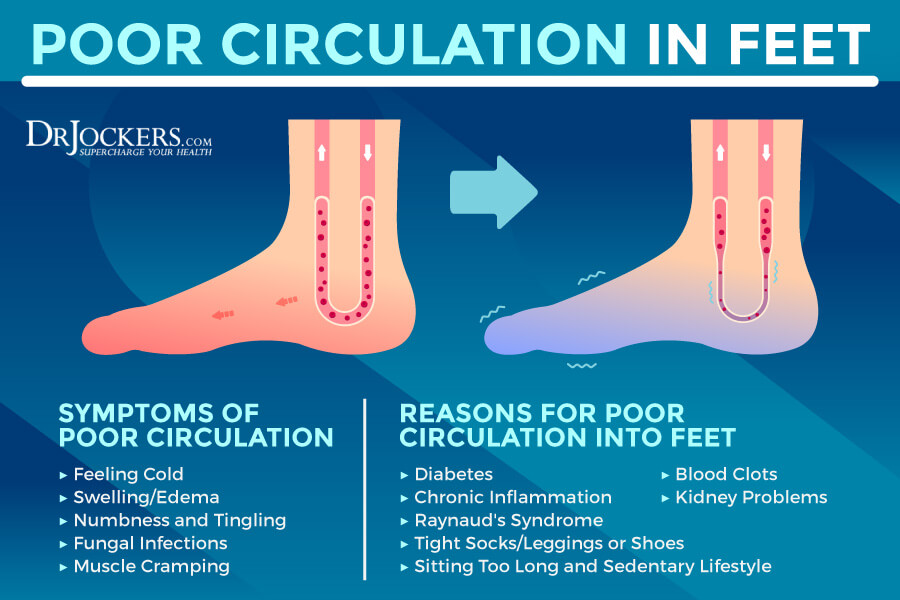
Natural Support Strategies
If you want to reduce your risk of toenail fungus and stop it from coming back, you need to address these underlying problems and improve your overall health. I recommend the following natural support strategies to improve your health and well-being if you have toenail fungus.
Anti-Inflammatory Nutrition Plan
Following an anti-inflammatory diet is one of the best ways to support your health and reduce the risk of underlying issues, such as insulin resistance, Candida, and fungal infections (6, 7, 5). I recommend removing refined sugar, refined oils, artificial ingredient, additives, junk food, and highly processed foods. Since sugar feeds Candida and can be a problem with insulin resistance, keep your carbohydrate intake to very low with low amounts of low glycemic index fruits only.
Focus on anti-inflammatory, nutrient-dense whole foods, such as greens, vegetables, sprouts, herbs, spices, fermented food, grass-fed beef, pasture-raised poultry and eggs, wild-caught fish, and wild game. Eat plenty of healthy fats, such as coconut oil, grass-fed butter and ghee, avocados, olives, and extra-virgin olive oil.
I recommend using anti-fungal herbs in your diets, such as oregano, garlic, ginger, turmeric, and cinnamon (10). Add them to your soups, baked dishes, and salads. You may also use ginger and turmeric in juices and as a tea. Later in this article, you will learn how to use anti-fungal herbs as supplements as well.

Intermittent Fasting
Intermittent fasting is a way of eating that cycles between periods of not eating (fasting) and periods reserved for meals (feasting) within one day. Intermittent fasting may offer many health benefits, including reduced inflammation, better insulin sensitivity, improved cellular repair, and overall better health.
According to a 2019 systematic review and meta-analysis published in the Journal of Clinical Medicine, intermittent fasting may improve insulin resistance (11). Since insulin resistance is one of the main underlying causes of toenail fungus, improving insulin sensitivity with intermittent fasting is a great idea (6, 7).
If you are new to intermittent fasting, the easiest way to start is with the Simple Fast. This method involves a 12 hour fast, including your overnight sleep. All you need to do is it stop eating after dinner and don’t eat until breakfast, 12 hours later, in the morning.
You can gradually increase your fasting window until you find what works the best for your body. Most people feel their best using the 16:8 method (16 hours fasting and 8 hours for your meals), but you may find that fasting for a somewhat longer or shorter period works better for you. To learn more about intermittent fasting, I recommend reading this article.

Reduce Stress & Improve Sleep
According to a 2016 review published in the Journal of Epidemiology, chronic stress may increase insulin resistance (12). According to a 2010 study published in the Journal of Clinical Endocrinology and Metabolism, sleep deprivation may also increase the risk of insulin resistance (13). Since insulin resistance is one of the main underlying causes of toenail fungus, reducing your stress levels and improving your sleep is critical (6, 7). Lower stress levels and quality sleep can also help your body to recover.
Reduce stress and interaction with people that bring you down from your life as much as you can. Decrease your stress levels with the help of breathwork, meditation, visualization, guided relaxation strategies, positive affirmations, and gratitude. Practicing yoga, Qi Gong, or Tai Chi may help you reduce stress levels. Journaling can help you release tension and spot and change negative thought patterns. Spend time in nature and with supportive friends and family members.
Support your body’s natural circadian rhythm by going to bed around the same time and waking up around the same time. As long as your work schedule allows it, go to bed at a reasonable hour in the evening and rise early in the morning with the sun. To improve sleep, avoid sugar, caffeine, heavy foods, and alcohol close to bedtime.
Avoid electronics at least 2 hours before going to sleep. Choose calming activities, such as reading fiction, poetry, or scripture, playing puzzles or crossword puzzles, journaling, knitting or crocheting, taking a bath, and time for gratitude and prayer. Support your sleep with a supportive bed, bedding, and pillows, blackout curtains, and an eye mask.

Good Hygiene Practices
Practice good hygiene to reduce your risk of toenail fungus and support your recovery. Wash your feet regularly. Wear clean flip-flops at higher-risk places, such as saunas, swimming pools, gym locker rooms, hotel bathrooms, and so on. Try antimicrobial socks and shoes made from copper, bamboo, or other specialty fabrics to further reduce your risk. Clean your bathroom regularly to reduce toenail and foot fungus from spreading.
Change your socks regularly and clean your socks and shoes regularly. You can wash both socks and athletic shoes in hot water to reduce the risk of fungus growth. Add a cup of vinegar or half a cup of baking soda to further eliminate fungus and bacteria in your socks and shoes. Wipe off shoes and boots that cannot be machine-washed with a vinegar and water solution. Allow your feet to breathe by being barefoot whenever possible and appropriate.
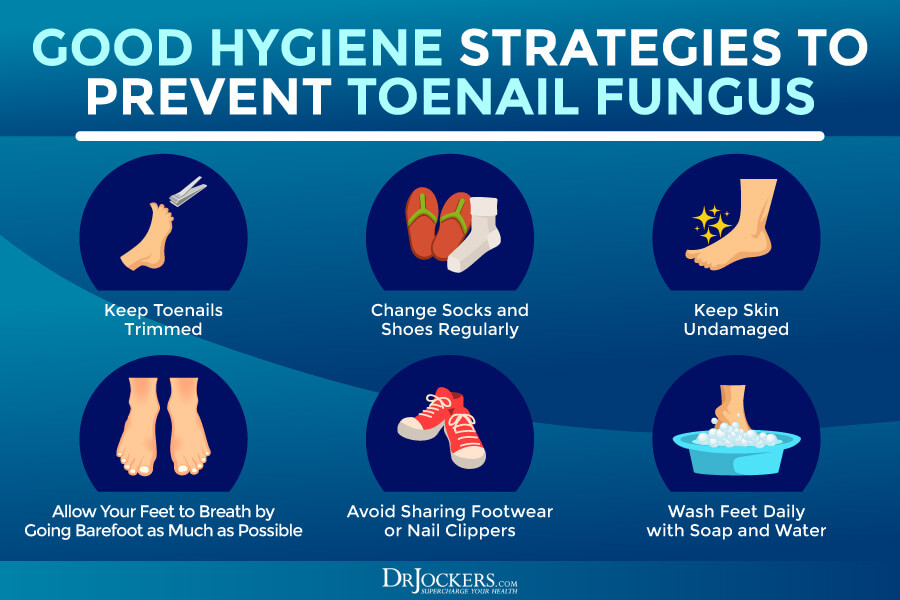
Remove Mold and Improve Air Quality
Mold is one of the top underlying causes of toenail fungus (1, 6). I recommend removing mold and addressing your indoor air quality to reduce mold exposure. Get help from a mold remediation specialist to check for hidden mold and remove it professionally. If there is a serious mold issue at your home, you may also want to consider moving, especially if you are renting and have less control over mold remediation or prevention.
Address underlying problems that may cause mold growth, including too much humidity, water leaks, too much moisture, old carpeting, and old wallpaper. In case of flooding or serious moisture leaks, clean and dry everything up quickly and get the problem fixed as soon as possible.
Improve your indoor air quality by installing a high-quality air filtration system. It helps to remove mold spores and other pollutants and toxins from your indoor air. It helps to reduce the risk of mold toxicity and other allergen and toxin exposure. During the warm and humid months of the year, use a dehumidifier or air conditioner. Using a dehumidifier may be a good idea in your bathroom year-round. If you are worried about mold at work, talk to your HR about mold remediation and indoor air filtration.

Use Anti-Fungal Herbs & Compounds
I recommend using some anti-fungal herbs and compounds in your diet and as a supplement to support your body fighting fungal infections.
Oregano
Oregano is well-researched for its anti-fungal properties. A 2001 study published in Molecular and Cellular Biochemistry has found that oregano may offer antifungal benefits against Candida overgrowth (14). You may use oregano in your cooking and use it as a supplement.
Olive Leaf
Olive leaf is another great antifungal plant. According to a 2015 study published in Current Medical Mycology, olive leaf may offer anti-fungal activities against Candida (15). You may use olive leaf as a supplement for fungal infections, such as toenail fungus.

Ginger
Ginger is a potent antifungal, antimicrobial, and anti-inflammatory herb. A 2016 study published in the Jundishapur Journal of Microbiology has found that ginger may have antifungal and antimicrobial benefits (16). You can use ginger in your cooking and as a supplement daily.
Clove
Cloves offer fantastic anti-fungal benefits. A 2009 study published in the Journal of Medical Microbiology has found that clove may offer antifungal protection against Candida (17). You may use cloves in your cooking and as part of a supplementation protocol.
Pau D’Arco
Pau d’Arco is a powerful antifungal herb. A 2001 study published in BMC Pharmacology has found that Pau d’Arco has anti-inflammatory and antimicrobial properties (18). I recommend using Pau d’Arco as a supplement for fungal infections.
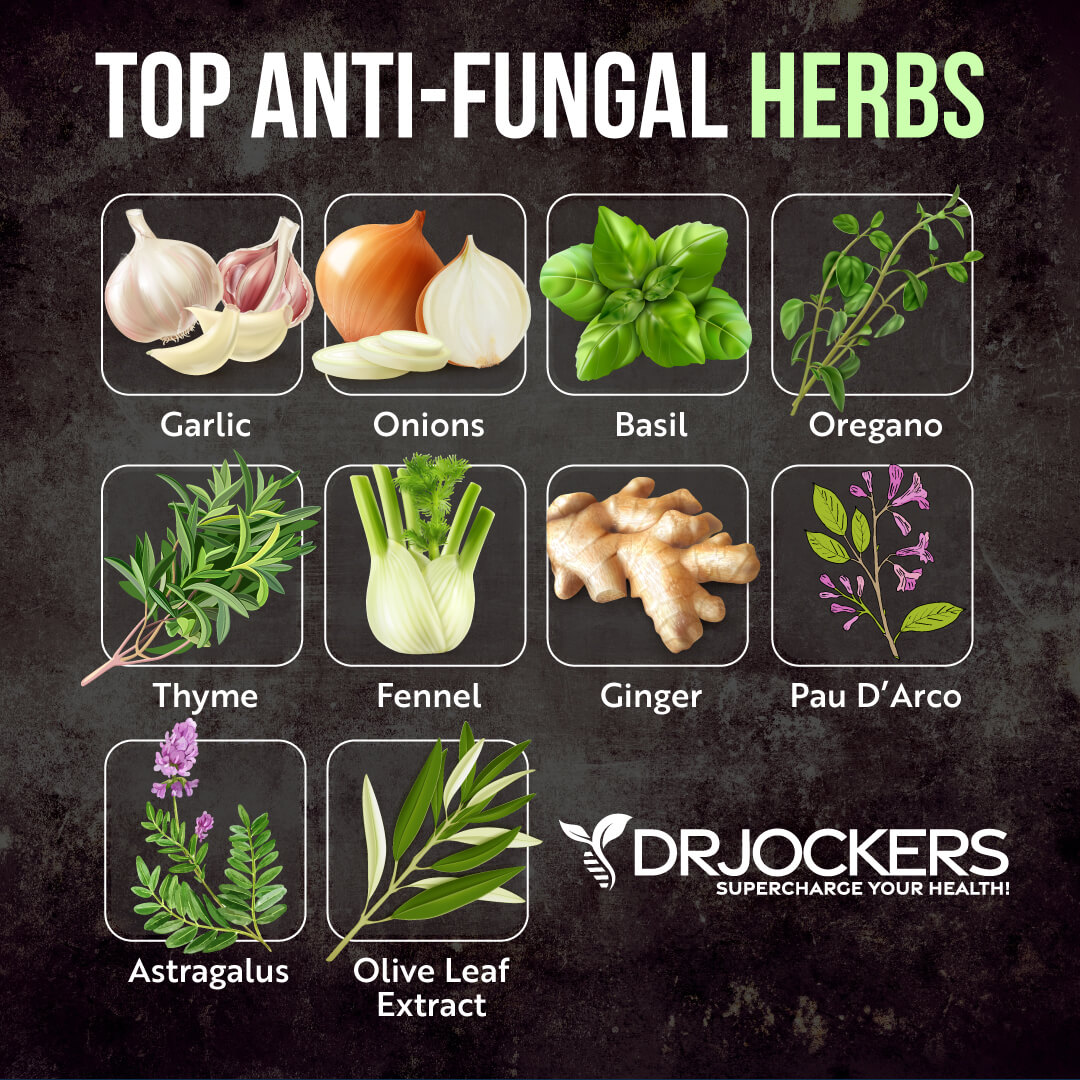
Caprylic Acid
Caprylic acid is a medium-chain fatty acid found in coconut oil, palm oil, the milk of bovines, and the milk of humans. A 2019 study published in Cellular Physiology and Biochemistry has found that caprylic acid may offer antifungal benefits against Candida infections (19).
I recommend using coconut oil in your diet and supplementing with caprylic acid. One supplement that uses this in the sodium caprylate form along with oregano, ginger, turmeric, olive leaf is Candida Elim.
Candida Support Pack
To support your body with the benefit of these anti-fungal herbs and other nutrients, I recommend the Candida Support Pack. This is an advanced supplement protocol to help someone break through and kick out the Candida. This goes along with a nutrient-dense, ketogenic style nutrition plan and healthy lifestyle habits.
The pack includes Candida and Candida Elim for antimicrobial and immune support, Activated Charcoal and Gut healing protein for detoxification support, Super DZyme for digestive support, and Gut Healing Protein and Candida for microbiome support. The combination of these supplements truly supports all areas of your body that need help.
Anti-Fungal Foot Bath
To treat your toenail fungus I also recommend an anti-fungal foot bath with anti-fungal ingredients, such as Epsom salts, hydrogen peroxide, baking soda, and vinegar are all anti-fungal.
You can mix one cup of Epsom salt to two quarts of warm to hot water and soak feet for 10 to 20 minutes. You could also try a more elaborate Epsom salt concoction that includes:
- 4 cups warm to hot water
- ½ cup Epsom salt
- ½ cup baking soda
- ¼ cup hydrogen peroxide
- ¼ cup vinegar
Mix all of the ingredients and soak feet for 15 to 20 minutes. Essential oils are a great addition to foot baths. Essential oils with healing properties to treat foot fungus are listed below. Following your foot soak, rinse your feet with clean water, and pat dry with a clean towel. To avoid contaminating clean feet, put on clean socks and breathable shoes following your foot bath.
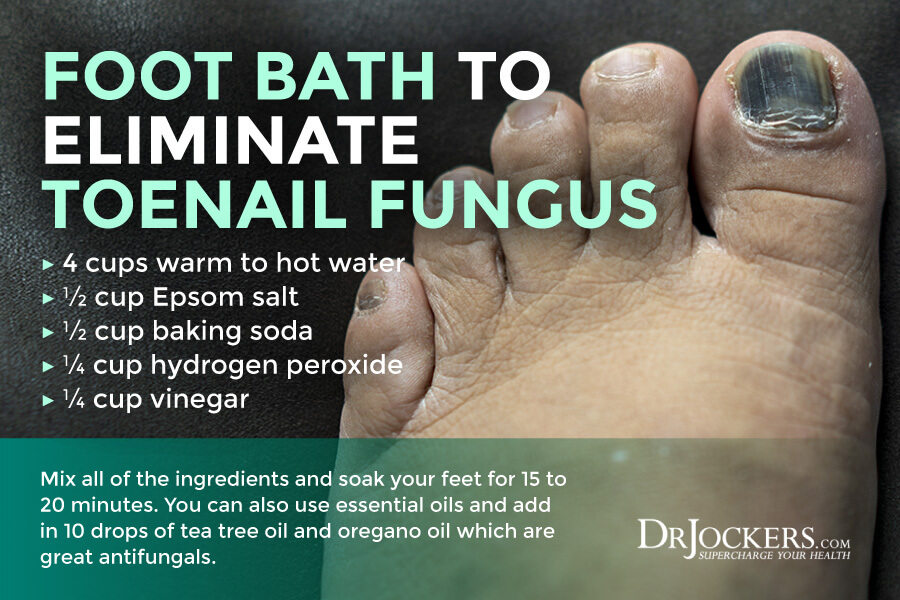
Apply Essential Oils
You may also apply anti-fungal essential oils following these two recipes:
Recipe 1:
Mix 3 drops of Tea Tree Oil with 2 drops of Oregano. Apply it directly on the toe fungus four times daily.
Recipe 2:
Apply 5 drops of Para 3 on fungal toenails four times a day. This also has biomolecular oxygen in it so it is the most effective strategy.
Final Thoughts
Toenail fungus is a fungal infection affecting your toenails causing discoloration, thickening, brittleness, and other toenail issues. Conventional treatment strategies for toenail fungus only tend to address the symptoms. Unfortunately, without addressing the root cause issues behind your problem, your toenail fungus will keep returning.
The good news is that by using a few natural support strategies you can address both your symptoms and the underlying causes to effectively remedy the problem. I recommend my top natural strategies for toenail fungus to improve your health and well-being.
If you want to work with a functional health coach, I recommend this article with tips on how to find a great coach. On our website, we offer long-distance functional health coaching programs. For further support with your health goals, just reach out—our fantastic coaches are here to support your journey.
Inflammation Crushing Ebundle
The Inflammation Crushing Ebundle is designed to help you improve your brain, liver, immune system and discover the healing strategies, foods and recipes to burn fat, reduce inflammation and Thrive in Life!
As a doctor of natural medicine, I have spent the past 20 years studying the best healing strategies and worked with hundreds of coaching clients, helping them overcome chronic health conditions and optimize their overall health.
In our Inflammation Crushing Ebundle, I have put together my very best strategies to reduce inflammation and optimize your healing potential. Take a look at what you will get inside these valuable guides below!







I had this problem for a couple of years. I went to a doctor, he told me this is not fungus.
I bought anti-fungal gel and was covering my toenails every day for about a year. As long as I was doing this my toenails were ok. The moment I had stopped a problem came back.
I found a cure by accident. I started to drink mineral water Pellegrino . Every day a bottle.
I heard that it is good for a digestion. After about a year my toenails completely recovered without doing anything else. Later I changed Pellegrino for even better mineral water.. with more silica.
Thank you for sharing your story Evee!
I know this article talks about toenails but what if my issue is fingernails. My toenails are fine.
Yes the same principles apply Donia!
Good article! I’d love to know what I should put on the nail bed. My podiatrist had to surgically remove my toe nail due to trauma, then infection) so the nail bed has had some trauma. He’s given me anti-fungal meds, but I’m afraid to use them too long since I know they have to be killing off good nail bacteria too. I’ve been using topical Argentyn Silver for the healing but feel I need to put something naturally antifungal on it next that would promote healthy nail growth. Any suggestions?
Yes tea tree oil works well, as does garlic and ACV.
I had toenail fungus since 14 years old now 61 is toe nail removal an option ?